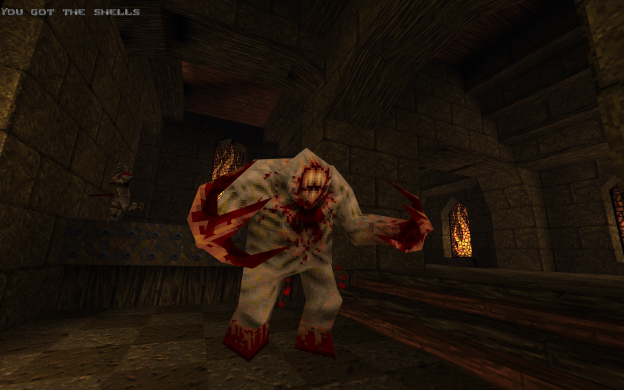So sock, level designer extraordinaire, had a tweet which triggered some interesting discussion:
Based on the amount of articles about #doom design and the lack of articles for #quake, is the later game play disliked that much? #gamedev
— Simon OCallaghan (@SimsOCallaghan) February 23, 2015
I didn’t directly participate, as on this subject I find Twitter’s character limit to be too restrictive. Jehar and negke jumped in with thoughts, but I figured I would share mine here. At a glance Doom and Quake seem to be similar games. First person shooters made by largely the same team, and with the same key people of Romero, Carmack, and Petersen at the helm. But they have many fundamental differences, such that I find it hard to articulate it succinctly. As negke has dubbed me a master of verbosity, I shall do my best to live up to that.
So why is Doom more written about than Quake? Why is the community more lively, and people outside of the community more aware of what goes on in Doom? Well these are all different factors. Doom is a 2d game, rendered in a 3d fashion, a method commonly called 2.5d. But video gaming is largely a 3d experience now, even if the gameplay is 2d, so the world of sectors and sprites stand in stark contrast to how we would look at a modern 3d game. This contrast makes for drama, and drama makes for clicks. When a Doom mod looks good, writers with little appreciation for art direction or technical accomplishments will gush, because in their minds, Doom is ancient. Quake may be ugly to them, but it is of the same paradigm: 3d worlds with 3d models. But Doom is like Sanskrit. This, however, is the least interesting aspect of the discussion.
Why is the community more lively? This is a matter of both technology and organization. Doom mapping is a rapid process. Want a room? Draw four lines. A skylight in that room? Four more lines. A triggered ambush? Three more lines for the monster closet, a line for a divider, and a line for the trigger. But a room in Quake? That is likely going to be six 3d objects (“brushes” is the accepted term) oriented in space touching each other, at different scales without any gaps between them. Then you need to place the character, and make sure he isn’t placed partially or fully inside of a surface, and then you need to light it with individual lights. No setting a light value in the sector. This creates a higher barrier of entry for community contribution, partially because even if you understand it, it simply takes more work to make the same space.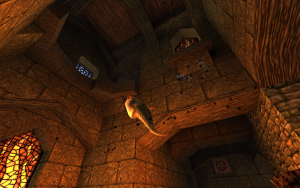
Quake is also scattered. The modders and engine coders are at Inside3d, the mappers are at func_msgboard, the map reviews are at Quaddicted, and the players are all over the place, including regionally focused websites. Quake Expo has brought the community together a few times, but doing one even halfway decently is a very large task. I did one alongside Sajt back in 2006, and with a low-responsibility part time job, no school, no social obligations, and months of planning, it was still a demanding event. In contrast, the Doom community seems to largely exist at Doomworld, and they have the annual Cacowards which is of a much saner scope, but still rallies the community (and greatly facilitates lurkers like myself with a convenient list of great downloads).
But none of this talks about the games themselves.
Quake is a 3d game, Doom is a 2d game. Quake is a game of rhythm, Doom is a game of speed.
Health and Damage
In Doom, the player can heal themselves with health potions for +1, which go over the base limit, by +10 to the limit, by +25 to the limit, exactly to the limit with a Berserk pack plus improved melee damage for the remainder of the level, +100 which goes over the limit, immediately set to 200 health and 200 blue armor, or be rendered completely invulnerable. There are many ways to be above optimum health in Doom. In Quake, you can heal yourself by +15 to the limit, +25 to the limit, or +100 over the limit, but your health rots back down to that limit. Invulnerability doesn’t protect your armor so you can come out of it for the worse, as armor is more valuable in Quake, and available in 3 variants instead of 2. Quake’s axe remains a last resort in every scenario. On the inverse, Quake has Quad Damage and it is beautiful in its simplicity. For 30 seconds, you are a god. In Doom, a moment’s profit can render you a god indefinitely.
Damage in Doom can come from monster hitscans, projectiles, melee attacks, crushing ceilings, and damaging floors. Damage in Quake can come from monster hitscans, projectiles, melee attacks, crushing ceilings, floors, walls, spike shooters, laser shooters, falling, drowning, or damaging materials – not floors, because you can submerse in them and they’re more difficult to escape.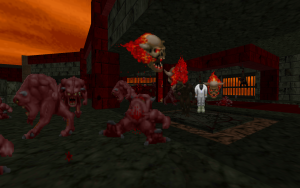
Doom attacks float along the environment, and most impact harmlessly against walls with the exception of a Cyberdemon’s rocket. Melee attacks are single frames of danger which you can zip in and out of. Quake’s melee attacks are transient states. While that Knight’s sword is being swung, it is doing multiple traces of smaller damage. Quake has you keeping a slightly larger distance, waiting slightly longer times. Meanwhile, fiends are leaping at you, spawn are bouncing off the walls, death knights are fanning fire bolts, shamblers are auto-aiming lightning, and vorepods hunt you mercilessly, just to keep you dancing in your brief moment of waiting. All the while, grenades bounce down off of support beams, rafters, or arc through the air if the gravity is low, because the ogres are always above you, always keeping you looking up, warily, but with an eye to the ground as well so as to not get near a grenade who’s fuse is still burning.
A lot of games are built around their tech. In Doom, maps were built to avoid 90 degree walls and flat sector heights like in Wolfenstein 3d. In Quake, maps were built to emphasize the third dimension, the fact that things can overlap. Quake is derisively called a tech demo, but I would say lovingly that it is a tech demo. It demonstrates that 3d can have gameplay implications, beyond being an aid for visual tricks and set pieces.
Weapons
It is fairly well known that Quake’s weapons were implemented in the relative last minute. They are simple progressions in damage output. Doom’s weapons are more of a toolkit, rather than more obvious upgrades.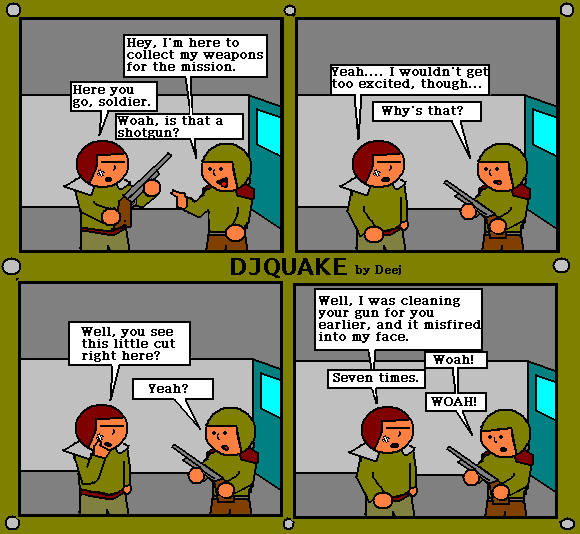
The result is an increase in player power, rather than in player expressions of power. Quake builds you up to a limit, Doom expands you and lets you stay above a standard. There is no analog to Doom’s BFG in Quake, and none to Quake’s lightning gun in Doom. Where Doom feeds you shells and bullets with item drops from former humans, Quake only gives such in the start of each episode (and e1m2), as well as a trickle of rockets from ogres. Killing a monster in Quake is almost always an expense on the ammo reserves, especially with how lacking the axe is.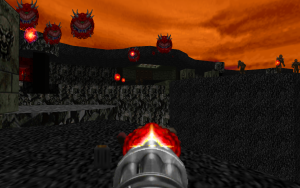
Then there is time to kill. The weakest monsters in Quake (grunt, rottweiler, rotfish) are all a minimum of 2 hits with normal weapons, and shots in Quake don’t penetrate. Doom meanwhile has multiple enemies you can kill with a single shotgun blast, or chew through a group of with the chaingun, or clear a hallway of with the double barreled shotgun. Doom’s mechanics favor numbers, Quake’s favor smaller encounters – likely due to performance concerns of a 3d environment with meshes over a 2d one with sprites. There is also a shorter upper range: Quake has no equivalent to a Cyberdemon or Spider Mastermind, and no common bullet sponge like the Baron of Hell.
Quake provides a constrained experience with an emphasis on monster combinations. Doom is good at monster combinations, but it also has the ability to wield numbers on its side.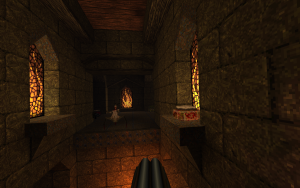
This could go on, and on, with more specific examples and examinations as to Doom’s 3 color keys that you keep versus Quake’s 2 which are removed on use, but as you begin to look at the games in this way, you notice a pretty different trend. Quake is not a snapshot game (that isn’t an InstaDoom pun, I promise) (never mind, it is). Doom is an excellent first person shooter with loads of nuance and a very high skill ceiling, but it is also a more immediately appreciated one. It has a lower barrier to entry for content creation, and a better organized community. Quake however grows on you, but that takes time spent playing. This is partially due to the 3d environments, something many people struggle with while playing.
There was an article on FPSPulse recently about introducing QuakeLive to League of Legends and CounterStrike players, and how they gradually appreciated the game, and this came partially from the more involved environments. Doom’s maps are nigh infinitely more complex than something we see from most developers, but they are all still inherently 2d spaces. It takes most people a while to adjust to more 3d spaces, and contemporary games provide no training in that.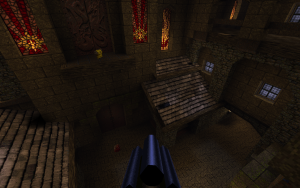
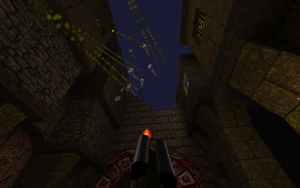
Quake is all about being 3d, the mechanics themselves encourage looking up, and forming a more coherent appreciation for the space around you, and respecting that space. This takes time to develop – as a contributor and as a player – and when you’re competing with tens of thousands of games for attention, time is the most expensive commodity.

